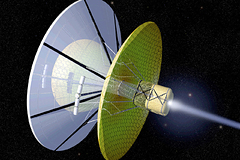Scientists in Austria and the United States have recognized Robert Bussard's interstellar drive as impossible
Physicists from Austria and the USA have refuted the performance of the Bussard engine, which, according to the hypothesis, can allow spacecraft to travel interstellar distances, and recognized its creation as impossible. This is reported in an article published in the journal Acta Astronautica.
The concept, created by Robert Bussard in 1960, provides for the capture of protons from outer space to support thermonuclear reactions. To do this, a magnetic funnel is used, which is created ahead of the ship. The theoretical possibility of such an engine was confirmed nine years later, when scientists first described magnetic fields suitable for capturing protons.
The researchers created a mathematical model of electromagnetic fields and recognized that the basic principle of particle capture really works. That is, protons can be collected from interstellar space and sent to a thermonuclear engine to reach speeds close to the speed of light.
However, the density of hydrogen atoms in interstellar space is quite low and reaches one per cubic centimeter. To effectively collect particles, a magnetic funnel must have gigantic dimensions, reaching diameters of four thousand kilometers, and lengths of 150 million kilometers. The authors note that this is technically impossible even for an advanced civilization.

